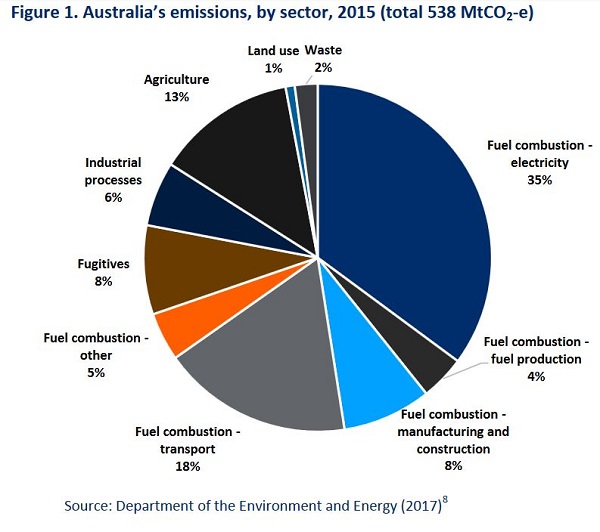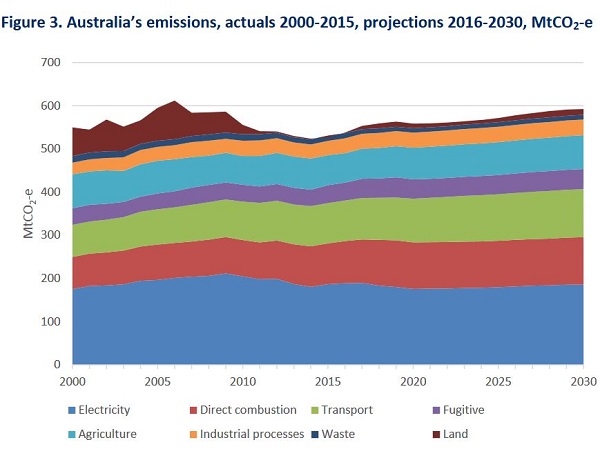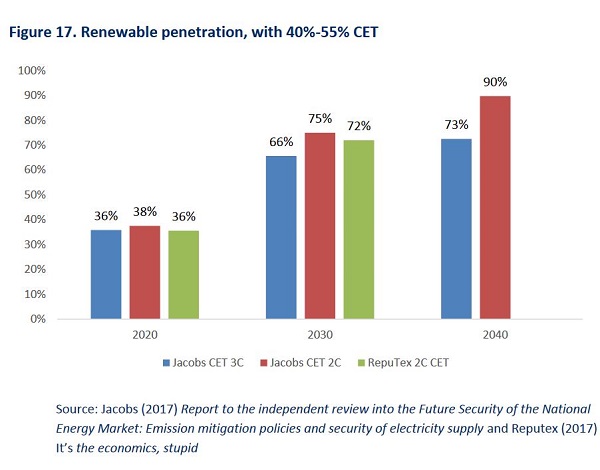 The Australia Institute has looked at the penetration of renewables required in the electricity market to meet our Paris commitments, and come to the conclusion that we need from 66 to 75% renewables by 2030, rather than the weak 26-28% currently being assumed in relation to the Finkel review.
The Australia Institute has looked at the penetration of renewables required in the electricity market to meet our Paris commitments, and come to the conclusion that we need from 66 to 75% renewables by 2030, rather than the weak 26-28% currently being assumed in relation to the Finkel review.
The basic issue is simple. If we don’t maximise the reductions in the electricity sector, we’ll have trouble meeting our overall Paris commitment, full stop. It will require a large and expensive effort in other areas such as agriculture. Completely decarbonising electricity was always the low hanging fruit. We appear to be ignoring this strategy completely, and the new report does not help all that much.
The Australia Institute’s report is downloadable from here, or go directly to the pdf.
Here is a pie chart showing Australia’s emissions in 2015 by sector:

Electricity represents only 35% of the total.
This graph shows the actual emissions to 2015, plus the projections out to 2030:

They say:
- Outside of the electricity sector, emissions are expected to increase by 20% over the period 2015-2030, driven mainly by increasing emissions from gas production, coal mining, transport and the beef industry.
Such growth would:
- leave an abatement task of between 842-1202 MtCO2-e to meet the 26-28% 2030 targets. This will require a suite of new policies,
potentially covering all relevant sectors of the economy.
A more appropriate strategy was set out in my 2013 post Climate change: reconnecting politics with reality (for future reference, it’s listed on the Key Posts page on the LHS side-bar), where I outline the approach suggested by John Wiseman, Deputy Director of the Melbourne Sustainable Society Institute at the University of Melbourne.
Wiseman says we would need a statement of urgency by the prime minister, then:
- we would need an Australian Climate Solutions Act which set up the targets, the structures and the priority actions. Principal amongst these would be an Australian Climate Solutions Taskforce chaired by the Prime Minister and drawing from state and local governments, business, trade unions and community organisations.
Then we would need six key action plans, the first of which would be an Australian Renewable Energy Plan to achieve 100 per cent renewable energy within 10 years, in other words by 2023.
This would be accompanied by plans in the other sectors, plus an Australian Climate Change Adaptation and Resilience Plan.
That was to achieve a 50% reduction in overall emissions by 2020, zero net emissions by 2040, then a carbon draw-down phase to get concentrations below 350 CO2e ppm.
I thought then that we should go for zero emissions by 2030 and 350 CO2e ppm 2050.
When we see the Australian government acting in a manner similar to what Wiseman suggested we’ll know our politics on climate change is connecting with reality. Anything short of that is abrogating our responsibility to future generations.
The Australia Institute report has lots of graphs about different ways to go, but I’m afraid it is never seized with the urgency of the situation. Their bottom line is to display the impact of modelling done by Jacobs Group and Reputex:

The problem here is that the modelling used treats 2°C and 3°C temperature gains as acceptable. See my The folly of two degrees from 2014 and Science shows the need for urgent climate action. As I said there, time to get the head out of the sand:

Press commentary includes The Guardian – Australia failing to meet Paris targets and more renewables needed, report says and the SMH – Climate crunch: Australia to fail on Paris commitments without massive renewable switch.
Abbott says the existing target is “unconscionable” and the Paris commitment was aspirational. He wants to essentially walk away from it and has threatened
to cross the floor if the government attempted to legislate a new clean energy target to replace the renewable energy target after 2020, a stance supported by backbenchers Craig Kelly and George Christensen.
Turnbull, to his credit, rejects efforts to ‘dumb down’ energy debate into renewables v coal. We will, we are told, have a new climate change policy by Christmas. It would be astonishing if it took climate change seriously in relation to what the science is telling us.

Great summary. I get the feeling that you are at a loss when confronted with the ongoing stupidity of Australian governments for the last four years. The thing that gets me is that this doesn’t even seem to be what Australians want, and yet somehow they are voting for these people – narrowly in the last election I know, but still more than should be according to what people tell opinion polls they actually want.
State governments do seem a bit better although the Labor government in Queensland seems to be trying to have it both ways on coal vs renewables, doesn’t it?
I mean eg apparently 80% want more focus on renewables, but 50% voted for the LNP in the last election, and 47% or so still would now.
I get that climate change isn’t their first concern, but polls also say people are concerned about growing inequality too, so why vote for the LNP? Because there is this persistent belief that they are ‘better managers of The Economy’ I suppose. Truly, ‘managing The Economy’ has become like a faith or cult in our society.
Electricity and fuel for transport are essentially one item as most transport needs to and will be electrified while at the same time being converted to all renewable sourcing. The forces that will bring this all about are not immediately obvious. Here is an alternative future look (though I think the timing is the only variable)…
http://www.abc.net.au/news/2017-09-26/self-driving-cars-could-change-your-life-within-six-years/8987628
Sorry I’m on a rant – but the reason people are so concerned about The Economy is because unemployment is a disaster for people, because the welfare state has been so eroded, so that makes them more worried about The Economy, and keeps conservative governments in, who go on eroding the welfare state. Vicious circle, isn’t it?
BilB
They seem to be suggesting ownership of cars will go down with autonomous cars, but not that driving cars will go down so much (the bit about people sharing cars is pie in the sky because they could do that now). From an environmental perspective, it’s driving cars that’s the problem, so I’m not convinced this is going to make a big difference.
Val, the problem with voting is that the parties post election cherry pick the election issues to say that “these issues are what the people voted for”, and the health of the planet is always first to be pushed aside. Why is this so? and how do they get away with it?
On the Labour side the danger is My Weasel Words himself, Anthony Albanese. It is important to ensure he does not become the Labour leader. If he did then we could write off another ten years of climate action as it would “always be suggested but never declared”.
Val, I had those thoughts when I heard this on the radio, but on reflection and after discussion with my daughter I think that this guy is on the money. I suggested to her that one of the things with cars is that they become part of our personal space which we fill with our “things” that we want to have handy. She pointed out that she does that with the bag she carries with herself to uni and when out. I do much the same. In London you will see nearly everyone alighting from the tubes with their “wheely bags” in tow. Londoners have already made that adjustment. What Seba is saying is that car ownership will reduce on a family basis (1 or 2 cars instead of four) with the convenience of transport on call and with zero need to perform the driving process personally. From the teenies/twenties point of view the party starts as a door to door experience rather than a who can and can’t and only at that place. When you think through situations the advantages are obvious once the fuel is electricity and the driver is not an included cost.
I don’t know if you are aware of this but in Singapore, and moving that way in China, one must have a certificate of entitlement before one can buy a car. These COE’s are auctioned and can cost $60,000 for a small 1.2 litre engined car.
A friend in Chicago, Shannon Roy (Aussie), put forward the suggestion that high rise city businesses could be required to pay the public transport cost of their employees, the argument being that their choice of business location makes it a requirement for people to travel large distances to reach their venues. Many businesses already do this I am told and that is a good direction as it would give governments the confidence to invest in better public transport.
It should be recognised that it is this central hub type development that drastically distorts real estate prices with huge cost to the community at large, so the justification for business funded public transport is well justified.
Just on Singapore, BilB
Back in 1994 I visited and was told the Certificate, or its equivalent then, was rationed and released by auction (hence high price). Ran for ten years and was transferrable to someone else.
An extra annual (?) charge if your vehicle was ever to enter the central zone. (Unlike the London congestion tax where you can purchase a day pass.) Total could be $100,000. All this before buying the actual car.
No wonder their MRT was so popular and excellent!
Indeed Ambi, Wikipaedia has the recent auction results. Note also that the COE is good for only 10 years when it must be renewed. So a small car costs $6000 per year to have the right to use it on Singapores limited length roads.
What did you think of Tony Seba’s predictions?
Val, Labor has long laboured under the impression that climate was not so urgent that we couldn’t continue burning coal for a few decades.
BilB, I think Albo missed the bus last time. It will probably go to Plibersek, or one of the younger people.
I’m not sure the Greens realise how bad things are either or they would be sounding the alarm. They are now consistently making the connection between coal and the reef, but that is fairly recent. Until recently they were mostly on about farm runoff and the reef.
Here is the RN talk on car futures…
http://radio.abc.net.au/programitem/peaD51V51D?play=true
(28 minutes)
BilB
I’m not sure about the timing with Tony Seba’s scenario.
Val makes a point that people could share car rides now, but don’t. Some years ago, living some 50km from work, I was able to car-pool on 4 of my 5 work days. Either 1/4 or 1/3 of the fuel costs those days and doubtless lower maintenance costs.
PT is only greener if passenger numbers are high. Val writes that it is the number of kms of car travel that matters. Yes and no. If the vehicles are solar-electric, then it’s the embodied emissions in the manufacture of vehicles and solar panels that matter. The number of kms travelled can remain steady with a much smaller ‘fleet’ of cars; if they are also solar-powered it’s win-win.
With petrol cars and coal-fired manufacturing we have both emissions from running vehicles AND embodied emissions in vehicles.
40 years ago my late father-in-law said that if a person lived in Melbourne, they didn’t need to own a car. He pointed to registration fees, insurance, maintenance and fuel costs; unless your job involved driving around all day, the car was little used.
At (outer suburban) Monash Uni years ago, parking fees used to be waived for cars whose drivers car-pooled. [Car-pooling or use of buses reduced the area of car parks needed].
Monash should have been built on a railway line, or had a spur line to it from Clayton station. It was car-choked.
I can well see urban folk dropping or reducing their car ownership.
Car-pooling can work, but is limited.
Train-pooling and electric tram-pooling may be more efficient.
In Exeter (mid 1980s) they had a fleet of public mini-buses whose movements were partly “on-demand”. A driver who had to leave a few people at a stop would immediately radio the HQ to despatch another mini-bus. [No app. Just clever.]
Ambi, the autonomous taxi is not actually carpooling, it is vehicle sharing, a very different structure. Carpooling is only possible where a group of people live in near proximity to one another, work at the same or near destination, and work to a similar time table. That is a lot of boxes to tick. My sister carpooled from the Blue Mountains to Sydney International for years, and that was possible because she was with Customs who have a huge staff, many of whom live in the Blue Mountains, and shifts are regular.
The demise of car pooling is really the story of the demise of the large workforced industry consecutive with the increasing abundance of cheaper good quality vehicles. My second job out of high schools was with Metters Ltd which in 1970 had 1450 people on the factory floor. Car pooling then was common. But businesses with that number of employees at one location are rare these days.
The autonomous taxi concept is an on demand service which will effectively “ride pool”, rather than “car pool”, with each person contributing to the cost of the ride on a daily basis.
Car pooling is very impressively widely practised in China, well organised with text messaging and participated uniformly from top executive down to factory floor. I experienced this on my one business trip to Qingdao.
I think it would be a mistake to prejudge the future based on present vehicle owning and driving habits, particularly in the face of the absolute certainty that the status quo is totally unsustainable even in the near medium term.
Hi BilB
I didn’t mean that car pooling was the same. I only meant it was an earlier form of vehicle sharing. You are correct in your description of when it works.
I should have said “train sharing” and “tram sharing”.
I think that Uber is opening some folk to the idea that a private car can be on the road more hours a day, at benefit to driver and customer, on demand of customer, when the driver chooses to make her car available. A glimpse of a little more flexibility and efficiency.
The taxi industry already has some cars shared out on 12 hour shifts.
But I’m not arguing that Tony’s suggestions are “nothing new”. Not at all.
The point I was making, Ambi, is that from the pie graph above the electrical share is as much as 53% as transportation fuel becomes electricity rather than fossil fuel.
To support that view I advanced the links, but there are many other indicators such as announcements from a number of european car manufacturers that they intend to discontinue the use of internal combustion engined vehicles by as soon as 2019 in Volvo’s case. Even China has indicated its intention to move in that direction in due course.
http://www.popularmechanics.com/cars/hybrid-electric/news/a28140/china-ban-cars-combustion-engines/
Australian vehicle importers other than Toyota are sitting on their hands on this claiming that Australian drivers only want V8 powered muscle cars.
I’m not sure if anyone wants to continue this conversation, but as a public health person my goal is to see ‘active transport’ as well as public transport (and shared transport, as I guess we can call it).
A while ago John Davidson pointed to some research showing a lot of commuting was less than 10 km which is doable by bicycle. I don’t see that it’s worth investing in driverless cars for most of those trips when they’d be better done by bike, for environmental (embodied emissions even if they are electrical vehicles using renewable energy) and health reasons.
Val, when I was a kid I walked and cycled everywhere. The times I was ferried by my parents were minimal. In later high school I would bike to the station, catch a train the 80 klm to Sydney, then cycle out to Moore Park (kicking taxi mudguards in traffic for their rudeness) to where the upholstery suppliers were for my materials, then cycle back to Central, train to Springwood, then cycle home. To live that way takes a measure of fitness and a huge amount of confidence, with confidence being the key ingredient.
You can’t just say to the public “now you have to start cycling, its good for the environment, and good for you too by the way”. Its not going to happen that way. You have to start from primary school and build a culture of cycling and maintain that all the way through high school. We don’t have the roads or the social structure for that to be safe at present.
You are also right that that is how we should shape the future and we need to be carefully considering the steps required to get to there. I go to an area of the Netherlands on the (Nieuwe) Maas River increasingly so am seeing how cycling works in the cycling central Europe. People here are extremely confident, girls in particular, with their cycles taking it for granted as being the better way to get around their local area. The roads and cycleways are very well established and you get told to get out of the way to let cycles through. It all works very well, and it can work that way here too in many areas (though not all).
One of the key features is security of being a lone person out an unprotected, how do we bridge that issue. One thing that has not yet come up in the discussions on autonomous vehicles is that they require some very special technologies to work safely specifically lidar, cameras, very fast computers, and inter connectivity. This parcel of features makes every powered up autonomous vehicle a potential cruising police car. So along with the fact that cycling safety increases dramatically with vehicles that are designed to avoid collisions with micro second reflexes, there is the added prospect of an every street, every minute, 24 hour surveillance functionality, meaning that public personal safety increases many fold by default. No doubt the privacy people are going to have a lot to say about that once the penny drops, but I am confident that proper protocols will alleviate those concerns while still providing better safety and crime deterrence.
Once we get some greater intelligence into the electric cycling power ratings, ie dump this ridiculous 240 watt power limitation, people will be able to use cycles for greater range excursions and in areas with more challenging landscapes (most of Australia). The move to make cycle helmets optional for casual cycling will also help greatly. They are my thoughts on the subject.
Val, I think that’s a great comment from BilB.
As someone who is a bit older, I’d look for three things. First, some protection from the weather. Heat, wind and rain are issues for much of the time around here. Second, something that will go up hills. Much of Brisbane is hilly, and it’s almost impossible to ride up our street as fast as walking pace, for example, unless you are an experienced, capable cyclist with very strong legs.
Third, enough space to carry the shopping.
At that point you might as well get something that can carry at least one passenger and some luggage.
I’d appreciate technology in a car which prevents you from crashing or bumping into anything, and being able to park itself in a tight spot.
Also, after 9 hours of hard physical activity, putting all ones tools on a push bike and riding ( multiple work destinations with varying distances ) home is not very appealing.
Good points Val.
At a primary school we know, both walking to school and cycling are encouraged. Some local signs are there to alert drivers to the road crossing points.
Our town is hilly, Brian. For some years we used Scandinavian electric assisted bicycles to help with hills. Assistance only if the rider pedals. Three gears, three levels of power, or no assistance. Monark brand.
Only a few dedicated bike paths so the safety concerns BilB highlighted were affecting our decisions to ride or drive.
In our town couples and larger groups are often out walking. More walkers than cyclists, except on Sunday mornings when lycra lizard veterans and longer distance riders gather for coffee and riding.
Moderate Victorian weather helps, no doubt.
Val: It takes me a bit longer (<15 mins) to go the 11 km into the CBD compared with a car during peak hrs. However, the case for biking gets a lot stronger when you compare the exercise + commute budget. In the case of a bike my exercise budget of approx 30 mins per day would be covered by a one way bike trip while the car commute would need an additional 30 mins exercise. (Works out about the same.)
An electric bike would reduce travel time, allow me to get to work without being all hot and sweaty while still meeting my exercise budget on the way home using pedal power only.
Driving in Brisbane peak hour traffic doesn't let you relax after work.
When I lived in Melbourne I rode my bike to the station and then caught the train to work. Getting to and from the stations provided some exercise but the useful thing I found was that riding the train provided time to wind down before I got home and plan the day before I got to work. While I never drove to work in Melbourne my guess is that my transport + exercise + windup/down time was better than what it would have been if I had driven to work. (Arriving home more relaxed was a bonus.)
In 1988, just in time for Expo, they extended the Queen Street Mall and opened the Myer Centre, with four levels of car parking, with access between Queen Street and the Botanic Gardens bend in the river, so only three ways out of the CBD. Peak hour traffic has been stuffed ever since.
JohnD, the cycling “power to work and pedal home” is an excellent suggestion for the better use of electric powered bikes.
Another potential advantage of e bikes is that they may allow the use of wet weather gear without turning you into a sweaty mess. (Will require a drive that can drive bike electric only.)